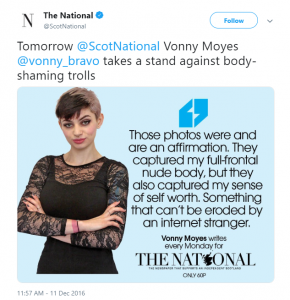[vc_row full_width=”stretch_row_content_no_spaces” full_height=”yes” css=”.vc_custom_1556706810688{background-image: url(https://www.indexoncensorship.org/wp-content/uploads/2019/01/index-report-online-harassment-cover-banner.png?id=104886) !important;background-position: center !important;background-repeat: no-repeat !important;background-size: contain !important;}”][vc_column][/vc_column][/vc_row][vc_row][vc_column][vc_custom_heading text=”Targeting the messenger: Journalists face an onslaught of online harassment” font_container=”tag:h1|text_align:left” use_theme_fonts=”yes”][vc_custom_heading text=”Mapping Media Freedom correspondents and other journalists discuss their experiences with harassment in the digital realm that has become so commonplace that it is underreported and underestimated.” use_theme_fonts=”yes”][vc_column_text]
“This reporter should be raped.”
This was the response from online trolls to Polish journalist Ada Borowicz after she published the story of an attack on a woman in Italy. Borowicz’s ‘crime’, apparently, was to have published the report without referring to the fact the attackers were alleged to have been migrants. Writing on Facebook Paweł Kukiz, a member of parliament and the leader of the right-wing populist movement Kukiz’15, described Borowicz’s reporting as “scandalous”.
Borowicz, who is also Mapping Media Freedom’s correspondent for Poland, was suspended from duties, and recalled from the assignment. Though her management did not give any explanation, she was told by a colleague that she was being punished on account of Kukiz’s Facebook post. The online threats followed.
When her contract with the government-controlled TVP Info was due to be renewed, an extension was not forthcoming.
Borowicz told Mapping Media Freedom that the story “was supposed to serve as an excuse not to welcome migrants. When my editors realised I wasn’t using harsh words against migrants they weren’t happy. A politician criticised me and then I was surprised to realise how aggressive internet users could be”.
Borowicz’s experience is all too familiar to many journalists, particularly women, throughout the 35 nations that are either European Union members or candidates for entry to the EU. Some 176 cases of online harassment were reported by Mapping Media Freedom correspondents between May 2014 and September 2018 – or one a week. These reports represent just a sliver of the threats against employment, of physical and sexual violence, and of death. Women journalists face malicious threats and are subjected to an extra layer of harassment invoking their gender in a sexually threatening and degrading way. The harassment is often the result of “dog-piling” – as in Borowicz’s case – or the product of an ongoing campaign by a determined troll.[/vc_column_text][vc_single_image image=”106541″ img_size=”full”][vc_row_inner][vc_column_inner width=”1/4″][vc_icon icon_fontawesome=”fa fa-file-pdf-o” color=”black” background_style=”rounded” size=”xl” align=”right”][/vc_column_inner][vc_column_inner width=”3/4″][vc_column_text]
DATA: Incidents involving online harassment of journalists in EU member, candidate and potential candidate states. May 2014-September 2018.
[/vc_column_text][/vc_column_inner][/vc_row_inner][vc_custom_heading text=”Tip of the iceberg” font_container=”tag:h3|text_align:left” use_theme_fonts=”yes”][vc_column_text]The cases in this report represent only the tip of the iceberg. Mapping Media Freedom correspondents – and investigations into online harassment published by Amnesty International, Reporters Without Borders and the International Federation of Journalists – have repeatedly told us that journalists don’t report all the harassment they receive on social media to their unions or the police, which means the number of publicised incidents far from reflects the true magnitude of the problem.
One of the reasons journalists don’t report online harassment is they get used to it and end up seeing it as being part of the job. Ilcho Cvetanoski, an Mapping Media Freedom Balkans correspondent, said: “One continues to report and report incidents to the police. And then at some point one stops reporting them, because it’s easy to end up thinking online harassment is normal.”[/vc_column_text][vc_row_inner][vc_column_inner][vc_custom_heading text=”A wave of abuse” font_container=”tag:h3|text_align:left” use_theme_fonts=”yes”][vc_column_text]Journalists also occasionally feel it’s not safe to speak up about the harassment they have suffered online, fearing it could make things worse and spark a backlash, leading to yet more abuse. Adrien Sénécat, a journalist at Les Décodeurs, Le Monde’s fact-checking section, which engages with readers and verifies stories that have gone viral, says the problem of online harassment is something that concerns him and his team directly. He has thought about reporting incidents – particularly libellous videos – to the police “but feared a Streisand effect so [I] didn’t”.
The online harassment of journalists can take the form of a wave of abuse directed at them. Sénécat likens it to aggressive school bullying. “When you write a story touching certain groups, it prompts very violent reactions which are not limited to the comments of the article but extend to your Twitter mentions, your direct messages, your emails,” he said. “And it can go further – in public forums, for instance. I did a story on bullying in schools, and this [continual] wave of notifications reminded me of how kids would be receiving bullying messages until four in the morning.”
Online harassment can also extend to real life, such as when information about a journalist’s address is published online – “doxing” – and the threats move offline.
Journalists describe feeling surprised at and being unprepared for the violence directed at them, and at the pack mentality of abusive internet users.[/vc_column_text][/vc_column_inner][/vc_row_inner][vc_custom_heading text=”Targeting women” font_container=”tag:h3|text_align:left” use_theme_fonts=”yes”][vc_column_text] A recent report by Amnesty International confirms women are particularly at risk of being insulted and intimidated on Twitter, and tend to be specifically targeted with an additional layer of violence if they are from a minority group. Women who have a public profile, such as politicians and journalists, suffer insults and threats, with private photos being leaked and published online.
A recent report by Amnesty International confirms women are particularly at risk of being insulted and intimidated on Twitter, and tend to be specifically targeted with an additional layer of violence if they are from a minority group. Women who have a public profile, such as politicians and journalists, suffer insults and threats, with private photos being leaked and published online.
In 2014, the International Women’s Media Foundation (IWMF) reported that two thirds of women polled in an international survey said they had been victims of online harassment.
In 2016, stolen nude photos of Vonny Leclerc (formerly Moyes), a journalist for Scottish newspaper The National, were posted online. She refused to be shamed, and tweeted: “This is the reality of being a female journalist right now. People like you try to use our own bodies against us. All the time.” She then published a nude photo of herself, saying nudity was not an object of shame for her.
Borowicz said: “As a woman, you are always a double target, since you are targeted as a professional and as a woman.”
Meanwhile, Lazara Marinkovic, Mapping Media Freedom’s correspondent in Serbia, said: “For women journalists, people always use the same low blows, based on looks, calling [them whores].”[/vc_column_text][vc_custom_heading text=”Toxic environments” font_container=”tag:h3|text_align:left” use_theme_fonts=”yes”][vc_column_text]When describing the media landscape in countries where there are large numbers of online harassment cases against journalists, our correspondents talk about toxic and polarised environments and of media landscapes largely controlled by governments (such as those in Poland and Serbia).
Marinkovic said: “Calling journalists, NGO workers or whoever is speaking critically about the government, traitors is a very common thing in Serbia. There is a very toxic environment in the media and on social media. There is a mob media mentality. I feel it’s getting much worse.”
She added: “Our ruling party has paid an army of bots to comment. Even the so-called democratic parties hire people to support their agenda online. They usually write positive comments [under pro-government articles] or follow a signal after a politician attacks a member of the opposition.”
Several of the cases on our database started with politicians abusing journalists online before continuing with media outlets running smear campaigns against them, and internet users perpetuating the abuse.[/vc_column_text][vc_custom_heading text=”Impunity” font_container=”tag:h3|text_align:left” use_theme_fonts=”yes”][vc_column_text]Cvetanoski believes a sense of impunity is one of the main reasons online harassment is happening.
“It’s quite easy to harass someone online. People think it’s a safe way to threaten someone,” he said. For example, in August 2018, a satirical comedian on Croatian TV received a death threat on Facebook, and was told “I know where and when you travel” and “You will get one in the back of the head, too, I swear”. When the police discovered that the harasser was a man from Split, the suspect confessed and said sorry, but he also expressed surprised that the police had managed to find him.
Journalists wanting to report online harassment often struggle with a lack of support or preparedness from online platforms, online publications and the police.
Sénécat points at Twitter’s failure to take action. “There’s a problem with Twitter, which doesn’t consider threats are threats unless people are saying ‘I am going to kill you’,” he said.
Meanwhile, referring to Serbia, Marinkovic said: “We have this prosecution office for online harassment. You can report, but they have so many cases and so many other priorities. When people report something they have to bring printed copies of the threats. It’s hard to picture how they operate.”[/vc_column_text][vc_custom_heading text=”Silencing journalists?” font_container=”tag:h3|text_align:left” use_theme_fonts=”yes”][vc_column_text]Online harassment can be effective in silencing journalists. When asked whether online harassment has impacted his work and that of his colleagues, Sénécat said: “We get intimidated by these communities. I notice it among my colleagues and me. Either you start battling with these trolls, antagonising them and answering them, [even though] this is not a rational discussion that can be resolved by a conversation, or you get intimidated, scared of writing about certain topics.
“For instance, if you write about Ulcan [a Franco-Israeli Zionist activist who repeatedly targets journalists whose views he disagrees with], you’ll be scared he’ll end up calling your family, causing your dad to have a heart attack, and you’re aware that writing about certain topics will mean you receive a lot of insults in your inbox.”
Across Europe, journalists are aware that reporting on certain topics is likely to spark online (and possibly offline) harassment against them. These sensitive themes include corruption (such as the mishandling of European funds in Bulgaria, which sparked harassment against investigative website Bivol), organised crime, women’s issues, toxic masculinity and online abuse (journalists reporting on trolling are often targeted), LGBT issues, the migrant crisis (in Greece, journalists reporting on the issue have been repeatedly targeted by supporters of the far-right Golden Dawn party), histories of conflicts (such as the 1990s Balkans war), and the far-right.[/vc_column_text][vc_custom_heading text=”Nadia Daam – a turning point in France” font_container=”tag:h3|text_align:left” use_theme_fonts=”yes”][vc_column_text]

Nadia Daam
The Nadia Daam case in France was seen as a turning point for online harassment cases. It showed that what is illegal offline is also illegal online.
In November 2017 Daam was subjected to an online harassment campaign after a broadcast on Europe 1 radio in which she discussed online forum Blabla 18-25. The users of the forum had flooded a phone number created by two activists keen to fight sexual harassment. Daam called the forum the “internet’s bin of non-recyclable trash”.
Following the broadcast, Daam was targeted on social media – particularly on Twitter. Libération reported that this abuse included pornographic insults, death threats and threats to her child. Her email address was used to subscribe her to pornographic and paedophile websites. There was also an overnight attempt to break into her house.
Daam published the threats she had received on her Twitter account. Two days later, Europe 1 announced she was suing. After a trial in July 2018, two men were given six-month suspended jail sentences and fined €6,000 for threatening Daam online. A third person threatened her and was given a six-month suspended sentence.
“A trial is already a victory,” the journalist said. “Online harassment is not bound to stop tomorrow but the message this trial is sending is we are able to track down the abusers.”[/vc_column_text][vc_custom_heading text=”Adrien Sénécat – establishing boundaries for online presence” font_container=”tag:h3|text_align:left” use_theme_fonts=”yes”][vc_column_text]

Adrien Sénécat
Adrien Sénécat is adamant that more needs to be done to prepare journalists on how to avoid online harassment.
“This could be talked about in journalism schools. It could be something that outlets tell you when you start a job with them. I always tell students in journalism school to be careful about what can be found about them online,” he said.
After suffering online harassment, he changed his behaviour, reducing his online presence and protecting his private life.
“I’ve deactivated notifications on Twitter,” he said. “Notifications are bad. There’s an accumulation effect. Doing this takes a weight off. You start taking some distance from Twitter and feeling better.”
He also reduced the information on him available online: “I’ve made sure my phone number was unlisted [and] that my address couldn’t be found online. I don’t put photos of my son on Facebook. I’ve changed a lot of things in my behaviour.”
It has also led him to reconsider his priorities as a journalist, which he says are not about building up a public profile on social media and becoming a celebrity but writing stories that start a debate on his publication’s website. He said: “We should start a better conversation about this. Our editors consider we need to write stories but don’t necessarily need to be on Twitter a lot. Twitter is not the space that’s the most important. Spending too much time on it distorts your perspective. Twitter is a space that has been colonised by hordes of malevolent internet users. For me, spending more than one hour on Twitter a day is harmful.”[/vc_column_text][vc_row_inner][vc_column_inner width=”1/2″][vc_column_text]
About this report
This report is part of a series based on data submitted to Mapping Media Freedom. This report reviewed 162 incidents involving investigative journalists from the 35 countries in or affiliated with the European Union between 1 May 2014 and 30 September 2018.
Mapping Media Freedom identifies threats, violations and limitations faced by media workers in 43 countries — throughout European Union member states, candidates for entry and neighbouring countries. The project is co-funded by the European Commission and managed by Index on Censorship as part of the European Centre for Press and Media Freedom (ECPMF).
Index on Censorship is a UK-based nonprofit that campaigns against censorship and promotes freedom of expression worldwide. Founded in 1972, Index has published some of the world’s leading writers and artists in its award-winning quarterly magazine, including Nadine Gordimer, Mario Vargas Llosa, Samuel Beckett and Kurt Vonnegut. Index promotes debate, monitors threats to free speech and supports individuals through its annual awards and fellowship program.
[/vc_column_text][/vc_column_inner][vc_column_inner width=”1/2″][vc_column_text]
Acknowledgements
AUTHOR Valeria Costa-Kostritsky
EDITING Adam Aiken, Sean Gallagher, Ryan McChrystal and Jodie Ginsberg with contributions by Joy Hyvarinen, Paula Kennedy and Mapping Media Freedom correspondents: João de Almeida Dias, Adriana Borowicz, Ilcho Cvetanoski, Jonas Elvander, Amanda Ferguson, Dominic Hinde, Investigative Reporting Project Italy, Linas Jegelevicius, Juris Kaza, David Kraft, Lazara Marinkovic, Fatjona Mejdini, Mitra Nazar, Silvia Nortes, Platform for Independent Journalism (P24), Katariina Salomaki, Zoltan Sipos, Michaela Terenzani, Pavel Theiner, Helle Tiikmaa, Christina Vasilaki, Lisa Weinberger
DESIGN Matthew Hasteley
[/vc_column_text][/vc_column_inner][/vc_row_inner][vc_row_inner][vc_column_inner width=”1/4″][vc_single_image image=”106454″ img_size=”full”][/vc_column_inner][vc_column_inner width=”1/4″][vc_single_image image=”106452″ img_size=”full”][/vc_column_inner][vc_column_inner width=”1/4″][vc_single_image image=”106450″ img_size=”full”][/vc_column_inner][vc_column_inner width=”1/4″][vc_single_image image=”106451″ img_size=”full”][/vc_column_inner][/vc_row_inner][/vc_column][/vc_row]
